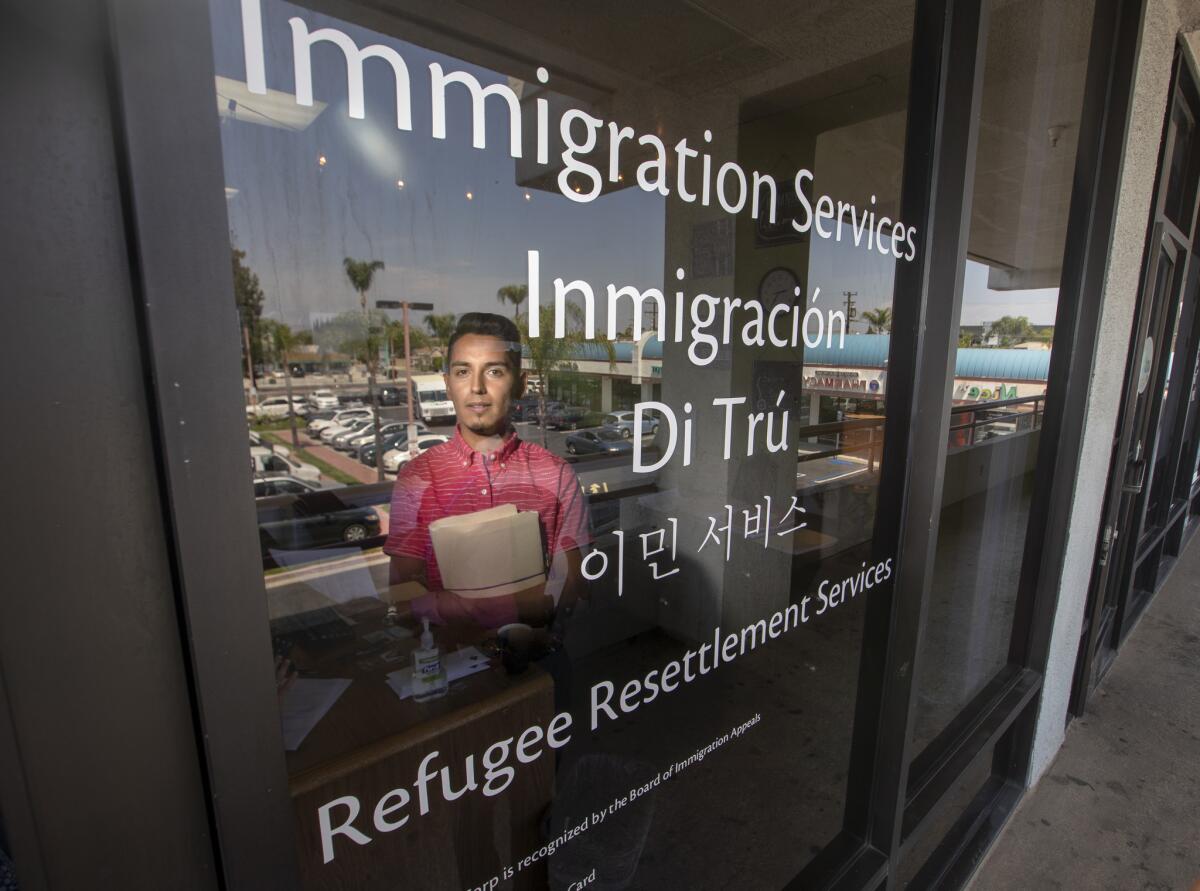Arrivals of refugees have hit historic lows. To stay afloat, resettlement agencies re-brand

The door to the nonprofit World Relief, tucked between a dance studio and a tutoring company on the second floor of a Garden Grove strip mall, still says “refugee resettlement services.”
But it’s been nearly a year since a new refugee has walked through it.
The number of refugees admitted to the U.S. since President Trump took office has dropped to its lowest level in decades. As a result, the office and dozens of other refugee resettlement operations across the country have been forced to close, shift their resources or re-brand.
In Eastern Iowa, the Archdiocese of Dubuque announced in December that it would end its 77-year-old resettlement operation, laying off some employees and transferring others to offices that include its immigration legal clinic.
At Catholic Charities in Minneapolis, officials said in May that they would stop resettling refugees and focus on helping a growing homeless population.
In Garden City, Kan., in Miami and Chicago, individual refugee offices are closing outright.
Nine nonprofits across the country are federally approved to resettle refugees and receive government funding for each case they handle. Until last year, each of them had an office in Southern California.
But World Relief and four others have shut down in the region, suspended operations, laid off staff or reduced their hours.
Messay Mengesha, one of hundreds of caseworkers hired across the country as refugee resettlement swelled during the administration of President Obama, joined the Garden Grove office of World Relief in 2015. It was once among the busiest resettlement operations in Orange County, having helped hundreds of Syrians, Iraqis and Afghans start new lives in the last few years.
But as the numbers dwindled in 2017, Mengesha had little to do.
“I was almost unemployed,” he said.
The office closed its refugee operation last July and shifted its resources to helping immigrants, which had long been a sideline of its operation.
Mengesha adapted too. He is now one of eight workers assigned to an increasing load of parents facing deportation orders, immigrant green card holders who want to become citizens, and Deferred Action for Childhood Arrivals recipients desperate for help paying hefty renewal fees. More caseworkers are being hired.
Nationwide, the decline in refugee admissions has been dramatic — down 70% in the first seven months of this fiscal year compared with the same period the previous year.
At current rates, about 22,000 refugees will have resettled in the U.S. between last October and the end of the fiscal year this September. That’s less than half of the cap of 45,000 set by Trump and the lowest number since Congress created a federal refugee resettlement program in 1980.
The number began to drop off last year after Trump signed travel bans that severely restricted refugee flows. Those orders expired, but refugee advocates say new vetting rules put in place in October make it nearly impossible for people from certain countries to move to the U.S.
Arrivals are down this year by 67% for refugees from African nations and 80% for those from the Middle East and South Asia when compared with averages for the last five years, according to a recent report from Human Rights Watch. The drops in refugees from Iran, Syria and Somalia are even greater.
The declines left many agencies depleted of federal funding and struggling to survive.
Even in places where new refugees are still arriving, changes are afoot. The International Rescue Committee office in Glendale, which once resettled more than a thousand refugees each year, has received only about 100 people this year.
“The need just isn’t there in the same way anymore,” said Martin Zogg, the group’s executive director. “So we have to give people other jobs to do.”
In Southern California, the scaling back has also left those refugees who do come with fewer places to turn for help. Many depend on assistance from agencies for longer than the 90 days the government guarantees.
Jose Velasco, a 19-year-old Salvadoran who now lives in Long Beach, was among the last refugee arrivals through World Relief when he landed in the U.S. in May 2017 with his mother and brother.
With little money, no jobs and minimal English skills, Velasco found that the short-term support the nonprofit offered through its resettlement program was not enough for him or his family. So World Relief referred them to a new nonprofit its supporters formed late last year.
That group, Home for Refugees, “helped me navigate the system to get into a high school,” said Velasco, who now works in a pizzeria and at a slaughterhouse. “They bought me books so I could study English.”
It’s the kind of support World Relief used to offer on its own.
“We’ve had a flood of people come to our doors asking if they can help us,” said Jose Serrano, the program manager at World Relief.
For the first time since it was established in 1979, the group recently posted a job opening for a volunteer coordinator.
“While we closed our refugee resettlement service,” he said. “We did not close our desire to help refugees.”
Sign up for Essential California
The most important California stories and recommendations in your inbox every morning.
You may occasionally receive promotional content from the Los Angeles Times.








